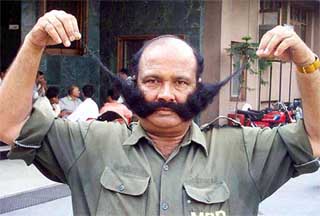
I spent the weekend in Udaipur, the Venice of India. The small city is in the heart of Rajastan, the land of traditions and…moustaches. Yes, the men wear the kind that point up at the end. Means they are strong.
I traveled alone and everyone was incredibly friendly so I met lots of people. One of the more interesting charactrers I met was Mukesh, who was a tour guide at the City Palace, the famous palace of the Mewar rulers. For a few bucks, I received a fabulous personal tour of the palace. Plus, Mukesh and I connected - we chatted about politics, culture and families.
At the end of the tour, Mukesh invited me to meet his wife and daughter. A few hours later, he picked me up on his scooter and we visited his home on the outskirts of town. Sitting like majarajas on their bed, Mukesh, his wife and I chatted, had chai and watched a Bollywood movie. And his five year daughter showed me her schoolbooks and favorite dolls. All was going well until Mukesh mentioned that his wife made jewelry. She pulled out boxes, spread her wares across the bedspread and the hard sell began.
Ultimately, I ended up buying a necklace. But I felt so uncomfortable. And disappointed. Maybe I was being naive, but I thought that I was slightly more than a customer. Perhaps this is unfair of me, especially considering the differences between our situations.
But I refused to let the incident ruin the evening. When Mukesh dropped me off, I told him that I neeeded to talk with him. While recognizing that we are from different cultures, I said that I would have appreciated it if he had let me know that his wife sold jewelry. He listened carefully and responded that he did not mean for me to feel pressured. We talked through the incident and the differences between our cultures. He noted that his wife was a stay-at-home mom who did not sell in the markets, only in their home to her family and friends. And I told him that I was more used to buying things in stores where the transaction was a little less personal.
In the end, I do not know whether Mukesh understood where I was coming from. But I felt so much better after our conversation. When it comes to complications of culture, some things are
not better left unsaid.
By the way, if you are ever in Udaipur, please look for Mukesh. He is a local treasure. Also, for all you James Bond fans, check out the photo below. You may recognize this from Octopussy...

(In case you were wondering, I did not stay at this hotel. Very expensive. But I did stay at the Mewar Haveli which I recommend highly!)


















































